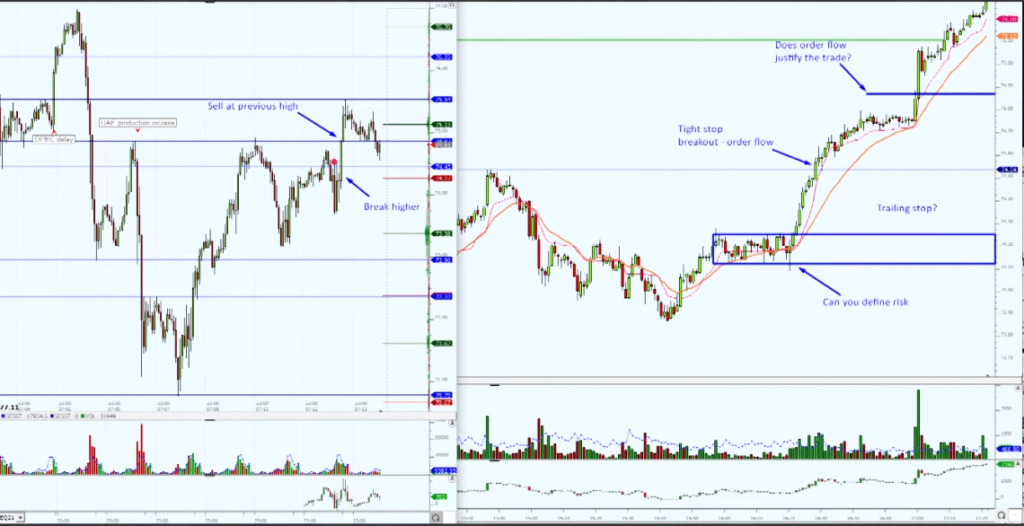Stop Placement Strategies Professional Traders Use Introduction
Have you ever wondered why so many strategies on the internet about stop placement simply don’t work? In this blog post, we will be discussing stop placement strategies that professional traders use. So, is there a holy grail of a stop placement? No, but there is something that comes very close to it. It is the “where am I wrong” type of real-time questioning before you place a trade. A line in the sand that defines the change. The stronger you feel that certain zone or level defines where you are wrong, the more you will be able to hold your trade through difficult times. But it is not just about the binary zone or level. Reading the orderflow will come in very handy, so don’t forget to check some of our previous posts such as the one where Harry managed his Gold trade using the orderflow: Trading The Multiweek Range Gold Breakout
This article is based on the video down below.
Stop Placement Strategies
Retail Traders Stop Placement Strategies
Before we start breaking down the stop placement strategies, the need to answer the key question: “How do you decide where your stop is placed?”. What are the criteria to consider? If you have been around for a while in the trading arena, you might have noticed by first-hand experience that a lot of recommendations on the internet are dead wrong. The two most common misconceptions about stop placement are:
- once in the money, move to breakeven
- stop defined by a number of fixed ticks
So what is wrong with these “strategies”? They are separated from the market. One is based on fear of losing and the other is based on dynamics that are not related to market price action. Take the stop at breakeven for example. Imagine you get long, you are immediately onsite and just to feel safe, to have a “free trade”, you move your stop to break even. By doing this, you are basically saying: “a moment ago, this was the best level to buy, but now it is the best level to sell”.
The same applies to a fixed number of ticks. Does the market know your number? Will the market care, that you set your stop at 6 ticks? Will it have any significance to the market? Absolutely not. Compare that to a stop placement, where large absorption happens, which means actual volume defending the price managed to hold the price. What do you think has higher significance? An arbitrary random number or actual volume of participants in the market?
Professional Traders Stop Placement Strategies
Now, this is as close to the holy grail as it gets. The professional traders placed their stops (both mentally and technically in the market) based on the understanding of where they are wrong. In the case of the news catalyst, the professional news hitter might be watching other correlated markets and their behavior. In a recent example, Elite Axia Trader traded the hawkish comment from the BoE while managing his trade in the pound and the Gilt. Because he understands the dynamics between Gilt, Pound, and Eurodollar, although the pound was lifting the offer rather slowly, he did not panic and not covered the pound trade. He knew that as long as Gilt is moving in the right direction, the pound is supported and even though it is lagging, there is no reason to cover. A correlation dynamics type of stop management. Compare this very subtle multidimensional stop placement strategy to a fixed number of ticks. Do you see the difference?
Another excellent example is a trade of different Elite Axia trader. While everyone was getting chopped to pieces holding onto Spoo short, this trader was able to hold onto the move and make almost one million dollars in one trade. Everyone was getting short this trade, but only a few could hold onto the move. What was his stop placement strategy? Part of his stop placement strategy was not only high conviction on trade but also the expectation of how the orderflow is gonna behave. Let me repeat that. This trader envisioned, based on the deep understanding of this particular setup, what type of the orderflow this trade will have and therefore was not surprised when the trade was tougher to hold onto.
What does it all mean? It is never the linear, it is always the subtle. The more you understand what you want to see and what you don’t want to see, the better you will become in creating “when and where I am wrong“. These are one of many criteria that can be considered for stop placement:
- type of the expected move (rhythm / personality)
- areas of high volume interest (absorption / initiative)
- order flow dynamics (icebergs, heavy hitters, heavy defenders)
- positioning (where are those that has positioned gonna bleed)
- contextual levels (weekly/daily highs and lows, VA’s)
- correlated markets dynamics
Oil Stop Placement Strategy Example
In the example down below, we can see a chart of the Oil trade. In this example, we were willing to get long the moment we broke out of the box. Before we broke, there might have been one instance, where if we would place our stop at the bottom of the range, we would be stopped out. What is interesting sometimes to observe is the other side of the range. We know we don’t want to get short but long. Sometimes it is worth watching the tight range to break the other side and immediately come back into the range. This might have been the last liquidity push that would help us to finally break higher. And it was indeed.
If you have watched the price ladder orderflow of this trade commented by Richard, you might have noticed his commentary on the further breakout. Every time he got into the key zone for a breakout, he was monitoring for sellers stepping in. If no sellers stepped in, the move is still good to go. Again, a feature that can be observed only from the price ladder. After the break, he did not move his stop to break even. He constantly questioned himself: where is he wrong and what would the market have to do to prove he is wrong.

So this is it for the stop placement strategies. Always consider them to be more subtle than just arbitrary numbers. There is always more depth that goes into defining them for professional traders.
In case you are interested in finding out more about trader training to learn how to trade and explore other great trading strategies, check out our futures trading course that teaches you exactly that and more. Or if you want to really maximize your ladder execution, check out our price ladder trading course.
If you liked this type of content, you might check these videos as well:
- How To Manage & Exit A Failed Breakout Trade
- Sign Of A Breakout About To Fail – Price Ladder Trading
- Market Profile Trading: Better Breakouts with Context and Volume Profiling
Thanks for reading and until next time, trade well.
JK




